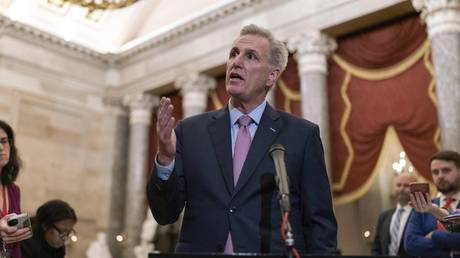Republican leader Kevin McCarthy was sworn in as speaker of the House of Representatives on Saturday morning, bringing a divisive week of infighting to a close and formally handing control of the House to the GOP.
A split in the party turned what is normally an uneventful procedure into an historic standoff, with 20 hardline Republican lawmakers holding up the process in a combined bid to thwart McCarthy’s appointment and squeeze concessions out of a leader they view as too establishment-friendly.
Who is Kevin McCarthy anyway? A nine-term congressman, McCarthy has represented his California district since 2007. He is a close ally of the fiscally conservative Paul Ryan – who served as speaker between 2015 and 2019 – and has moved in the party’s top circles for almost a decade, having been majority leader from 2014 to 2019, and minority leader from 2019 until now.
McCarthy was an early supporter of former President Donald Trump and aligned with him on most issues throughout his presidency. However, he distanced himself from Trump’s claims of fraud after the 2020 election. The two subsequently reconciled, and Trump endorsed his bid for speaker.
Why did it take so long? Republicans hold a 222-213 seat majority in the House, which would be enough for McCarthy to comfortably win the speakership under normal circumstances. However, it took 15 rounds of voting for him to be confirmed, thanks to opposition from the GOP’s more conservative wing, many of them members of the pro-Trump ‘Freedom Caucus’.
In the first round, 19 Republicans opposed McCarthy, before that number whittled down to six who voted ‘present’ in the 15th and final round. The last time the House went beyond a single round to confirm a speaker was in 1923.
What did his opponents want? The Freedom Caucus has long argued that McCarthy is too amenable to compromise with the Democratic Party, and not aggressive enough on immigration, spending reform, or regulating Big Tech corporations.
READ MORE: US lawmaker calls out Zelensky’s ‘North Korea-style’ speech
While some members of this group – such as Florida Rep. Matt Gaetz – remained opposed to McCarthy until the final vote, others demanded a set of rules granting them more time to review legislation before voting, more authority over the removal of a speaker during Congress’ term, and powerful committee assignments.
What is McCarthy’s stance on Ukraine?
Read more
US to arm Kiev with Sea Sparrows
Earlier this week, Gaetz said of McCarthy that “time and again his viewpoints, his positions, they shift like sands underneath you.” On the issue of US military aid to Ukraine – which almost all Democrats and Republicans enthusiastically support and some members of the Freedom Caucus oppose – this appears to be the case.
McCarthy said before November’s midterm elections that should the GOP retake Congress, they would no longer give Kiev “a blank check.” Pressed by CNN several days later, he insisted that he is “very supportive of Ukraine,” but would push for “accountability.”
McCarthy voted in favor of a $40 billion package of economic and military aid for Ukraine in May, but against a massive $1.7 trillion spending bill containing another $40 billion for Kiev in December.
What do voters think? Fewer than half (48%) of Republican voters wanted the GOP to elect McCarthy as speaker, according to a Rasmussen poll taken earlier this week. Meanwhile, 29% said that he should be dropped from contention, while 23% were undecided.
What happens next? With the deadlock resolved, the House can return to business as usual – voting on legislation and conducting oversight of government departments. McCarthy has promised a bill on border security, and pledged that his committees will investigate the Biden family’s allegedly corrupt foreign dealings, probe the FBI’s role in online censorship, and look into the origins of Covid-19.













